30 Low Maintenance Perennials for a Shade Garden
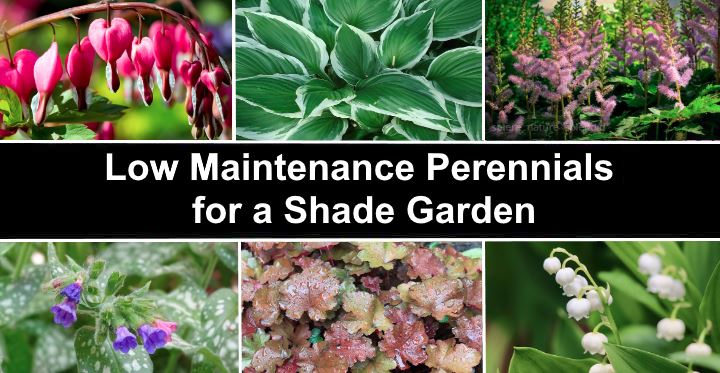
Finding low-maintenance perennials that thrive in low-light conditions can be challenging. Many perennial flowers, shrubs, bulbs, and grasses can become leggy or perform poorly in shade gardens. However, finding low-maintenance perennials for partial to deep shade conditions is possible. Many easy-care plants don’t just survive in the shade—they thrive in shady gardens.
This article is a guide to finding the best shade-loving, easy-to-grow plants for enhancing your full-shade perennial garden.
What is a Shade Garden?
A shade garden has low light exposure or no direct sunlight. Due to buildings, large trees, or shrubs, part or all of the garden could be in constant shadows. Sometimes, the shade may only affect specific times of the day, like afternoon shade. In these areas, the ground is cooler and retains more moisture.
Of course, all vegetation needs some level of light to grow. However, low-maintenance, shade-loving plants for perennial gardens can thrive on little or no direct sunlight.
Understanding Different Shade Levels Shade
Understanding different levels of shade is vital when choosing the best easy-care shade plants. Here is a quick guide on how to know how many hours of sunlight shade perennials require.
Full shade: This refers to two hours of direct sunlight or less daily. Areas in full shade only receive ambient light without the sun’s rays directly. Sometimes, it’s referred to as deep shade or heavy shade.
Partial shade: Also called part shade, these areas of a yard get four to six hours of daily sunlight. Typically, the direct sunshine is in the morning when sunlight is less intense.
Dappled shade: This type of light exposure refers to filtered sunlight through foliage. Also called dappled sunlight, this shade level creates speckled shadows on the ground. It is common near trees or large shrubs with open canopies.
What are Perennial Plants?
Perennials are plants that live more than two years. They survive in the ground through winter and regrow each spring from the same roots. Unlike annuals—which die in winter—perennial plants persist through multiple growing seasons, showcasing a wide range of flowers, foliage, and forms.
What are Evergreen Perennials?
Evergreen perennials are plants that maintain their foliage year-round, providing consistent greenery regardless of the season. These resilient plants offer enduring beauty and structure to gardens, with leaves that persist through winter. They thrive in various climates, making them a reliable choice for year-round landscaping appeal.
Evergreen perennials vs. evergreen shrubs
Evergreen perennials are herbaceous, non-woody plants with leaves that don’t drop in the fall. They can include evergreen vines, leafy plants, and ground covers. Evergreen shrubs have woody stems. Both plant types provide year-round greenery but differ in size, structure, and growth habits. Therefore, they offer versatile options for landscaping in all climates.
Low Maintenance Perennials For a Shade Garden
Let’s look in detail at the best low-maintenance perennials that thrive in shade conditions in front or backyards.
Hosta (Hosta)

Hosta is a popular perennial that thrives in the shade. Hostas are known for their large, thick, wedge or heart-shaped leaves and clusters of creamy-white tubular flowers on tall stems. The shade-loving clumping perennials typically don’t grow taller than 2 ft. (0.6 m) tall.
Hostas thrive in moist, well-drained soil that is common in shaded areas. Depending on the variety, hosta leaves can be variegated green and creamy white, blueish-green, or green with yellow margins. Some hostas have glossy dark green leaves curled or folded into tube-like foliage.
The beauty of hostas for shade gardens is their low maintenance. The easy-care perennials grow in deep shade, providing foliage and texture where other plants struggle. Hostas perform well in shady borders, shrubs and trees underplanting, foundation planting, woodland gardens, and ground cover.
- USDA Growing Zone: 3 to 9
- Blooming Time: From late spring through early fall
- Flower Colors: White, lavender, or purple
- Light: Deep shade to part shade
- Soil: Moist, well-drained, fertile soils
- Mature Size: 1 to 2 ft. (0.3 to 0.6 m) tall and up to 3 ft. (0.9 m) wide
Astilbe

Astilbe thrives in heavy shade, booming in summer with feathery plumes of pink, white, red, and purple shades. This attractive flowering perennial has ornamental value due to its arching flower clusters and fern-like leaves on tall, upright stems. Astilbe is ideal for adding a pop of color to shaded garden areas.
Astilbe grows up to 3 ft. (0.9 m) tall. The long-lasting flower plumes continue to bloom despite growing in partial to deep shade. Additionally, the perennial’s foliage is rabbit and deer-resistant, making it a great choice in rural areas. Astilbe is ideal for shady perennial borders, woodland gardens, and north-facing gardens.
- USDA Growing Zone: 4 to 9
- Blooming Time: Late spring to early summer
- Flower Colors: Pink, red, white, and purple
- Light: Full sun, dappled shade, and heavy shade
- Soil: Organically rich, moist, well-draining soil
- Mature Size: 2 to 3 ft. (0.6 – 0.9 m) tall and wide
Coral Bells (Heuchera)
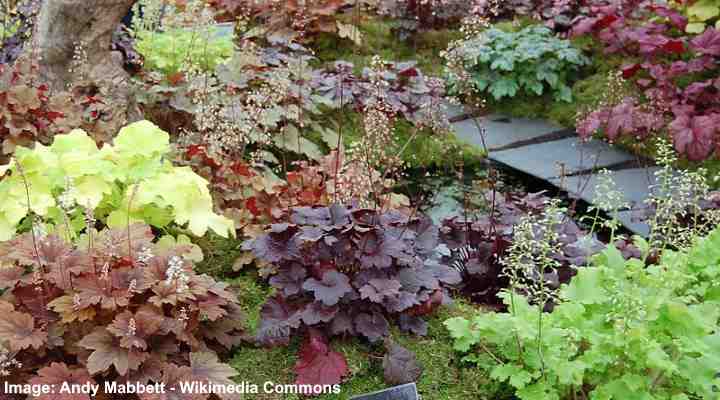
Coral bells are colorful perennials with vibrant foliage and clusters of bell-shaped flowers that perform well in shade gardens. These attractive plants have a mound-like growth with striking heart-shaped leaves. The foliage color includes lime green, deep red, brown, silver, and purple shades. Some of the showiest coral bell varieties have variegated or patterned leaves.
Growing up to 2 ft. (0.6 m), coral bells are easy-care perennials for a range of growing conditions. They are ideal for adding color and texture to shaded borders, rock gardens, and colorful ground cover in full shade. These perennials are also deer-resistant and attract hummingbirds.
- USDA Growing Zone: 4 to 9
- Blooming Time: Spring and summer
- Flower Colors: White, pink, or red
- Light: Full sun, part shade, deep shade
- Soil: Consistently moist, well-draining, rich soils
- Mature Size: 1 to 2 ft. (0.3 – 0.6 m) tall and wide
Bleeding Heart (Dicentra spectabilis)
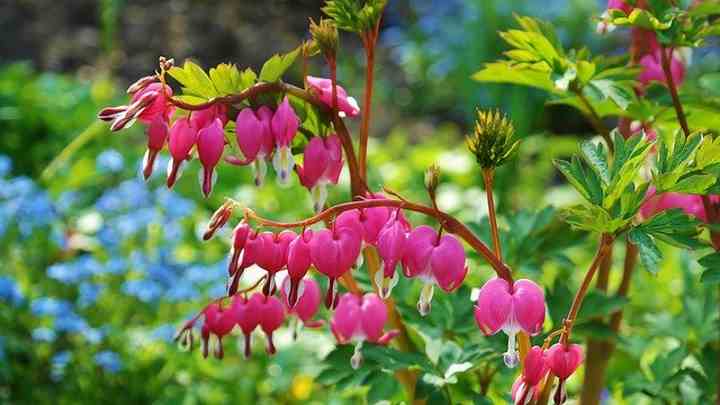
Bleeding heart is a beautiful perennial with heart-shaped flowers dangling from arching stems. Ideal for dappled sunlight and partial shade, the pink or white flowers contrast nicely with bold green, divided, fern-like foliage. This long-lived perennial blooms for six weeks from mid-summer, growing up to 3 ft. (0.9 m) tall.
The low-maintenance shade plant is ideal for understory planting. It thrives alongside other shade-loving perennials like ferns, astilbe, hostas, and lungwort. In complete shade, the perennial has sparse flowers. It will also grow in full sun but requires constant watering to thrive.
- USDA Growing Zone: 3 to 9
- Blooming Time: Late spring to early summer
- Flower Colors: Pink and white
- Light: Partial shade
- Soil: Well-draining, humus-rich soil
- Mature Size: 2 to 3 ft. (0.6 – 0.9 m) tall and wide
Lungwort (Pulmonaria)
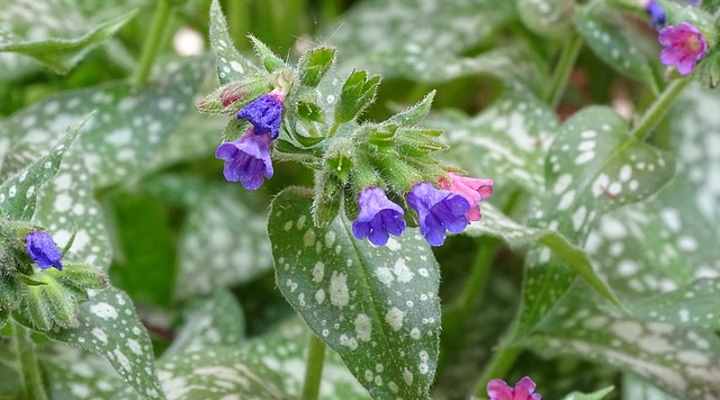
Lungwort is a versatile low-light perennial known for attractive, colorful early spring flowers. Ornamental features of this easy-care shade plant are its large lanceolate leaves with silvery speckles or mottled patterns and bell-shaped blossoms in pink, blue, and purple shades. Lungwort typically blooms in early to mid-spring.
Lungwort grows up to 12” (30 cm) tall and has a spreading habit. As one of the earliest perennials to bloom, the flowers add a splash of color to late winter and early spring landscapes. They also brighten shady borders and areas under trees where other plants struggle due to a lack of sunlight.
Lungwort is deer and rabbit-resistant and attracts early pollinators such as bees and butterflies.
- USDA Growing Zone: 3 to 9
- Blooming Time: Early spring
- Flower Colors: Pink, purple, blue
- Light: Partial shade or full shade
- Soil: Moist, well-draining
- Mature Size: Up to 1 ft. (0.3 m) tall and 2 ft. (0.6 m) wide
Japanese Forest Grass (Hakonechloa macra)
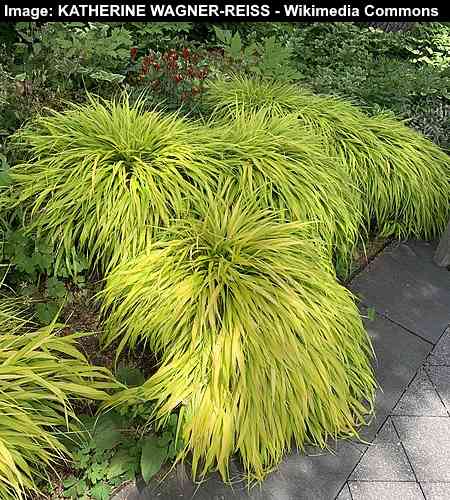
Hakonechloa macra ‘All Gold’
Japanese forest grass is a beautiful perennial grass that adds texture and color to shaded gardens. This grass features cascading, arching leaves in shades of green, gold, and variegated varieties. In the fall, its color transforms into eye-catching red and bronze colors. It’s one of the few ornamental grasses suitable for heavy shade.
Also called Hakone grass, the bushy ornamental grass grows up to 2 ft. (0.6 m) tall. Its tolerance for shade makes it great for borders, underplanting trees, as an accent plant, or as a ground cover in low or no light conditions. This perennial grass is easy to care for and resistant to most pests and diseases.
Japanese forest grass adds a touch of beauty and tranquility to any garden, making it a popular choice among gardeners.
- USDA Growing Zone: 5 to 9
- Light: Partial shade to full shade
- Soil: Moist, humus-rich, well-drained soils
- Mature Size: 1 to 2 ft. (0.3 to 0.6 m) tall and wide
Periwinkle (Vinca major and Vinca minor)

Periwinkle is a vigorous mat-forming evergreen perennial that thrives in deep shade or full sun. These shade-loving plants are known for their eye-catching five-petalled purple flowers, glossy green, ovate leaves, and spreading habit. Additionally, periwinkles have a long-blooming season—from early spring through late fall.
There are two main species of periwinkle—lesser periwinkle and big periwinkle.
Big periwinkle (Vinca major): This evergreen perennial thrives in full shade. Its features are large violet-blue flowers, glossy lance-shaped leaves, and dense foliage. It grows up to 2 ft. (0.6 m) tall and spreads through trailing stems indefinitely.
Lesser periwinkle (Vinca minor): This is a great easy-care perennial for ground cover in shade gardens. It’s fast-growing and blooms with small purple star-shaped flowers in spring. Only growing 6” (15 cm) tall, the drought-tolerant perennial is ideal for preventing soil erosion or underplanting shrubs.
- USDA Growing Zone: 4 to 9
- Blooming Time: Early spring through late fall
- Flower Colors: Purple and blue
- Light: Full sun, partial shade, or deep shade
- Soil: Well-draining dry to medium moisture soils
- Mature Size: 6” to 2 ft. (0.15 – 0.6 m) tall and 2 ft. (0.6 m) wide
Lily of the Valley (Convallaria majalis)
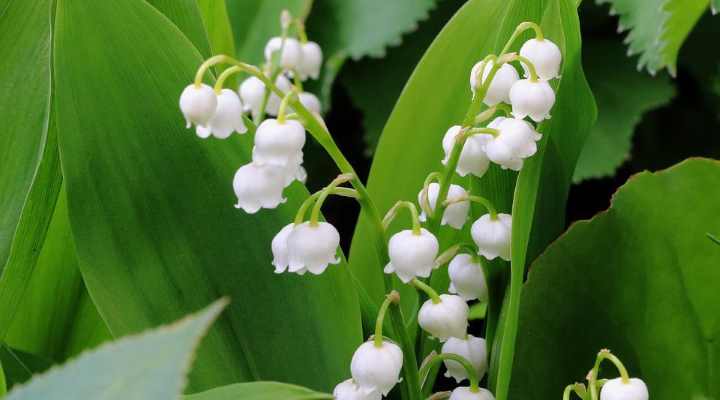
Lily of the valley is a fragrant, shade-loving perennial that grows easily in damp, heavy clay soil. This white-flowering plant is known for its brilliant white bell-shaped flowers dangling from arching stems. The sweetly scented flowers bloom in late spring. Also, the outstanding woodland perennial has attractive, broad, lanceolate leaves growing in dense clumps.
Lily of the valley grows up to 12” (30 cm) tall and spreads through rhizomes, forming a dense ground cover. This low-maintenance shade perennial also performs well in garden edges, shaded borders, and under larger shrubs.
It’s important to remember that lily of the valley is toxic, and you must handle it with care.
- USDA Growing Zone: 2 to 7
- Blooming Time: Late spring to early summer
- Flower Color: White
- Light: Partial shade or full shade
- Soil: Well-drained soil that is constantly moist
- Mature Size: 1 ft. (0.3 m) tall and wide
Shade-Loving Hydrangeas (Hydrangea spp.)

Hydrangeas are beautiful, shade-loving perennials that add a touch of elegance to any garden. These shrubs produce large, round flowerheads in shades of blue, pink, purple, and white. The flowers are made up of clusters of small, individual flowers, creating a stunning display. Hydrangeas have large, glossy leaves that add to their overall appeal.
Here are four hydrangeas that thrive in the shade or partial shade:
Bigleaf Hydrangea ‘Big Daddy’ (Hydrangea macrophylla ‘Big Daddy’): This woody deciduous perennial shrub has large rounded sky-blue or pink flowerheads 14” (35 cm) across. It thrives in part shade or full shade and grows 5 to 6 ft. (1.5 – 1.8 m) tall.
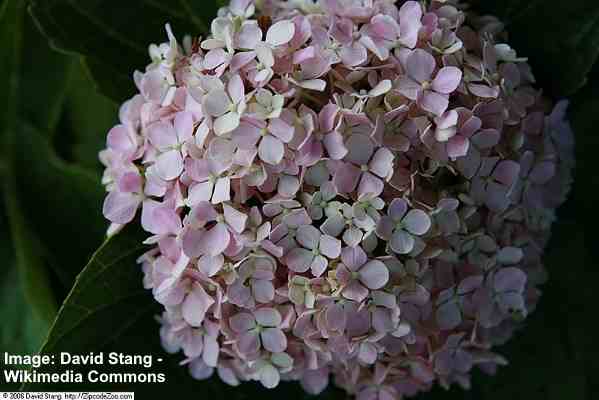
Hydrangea macrophylla ‘Big Daddy’
Nikko Blue Hydrangea (Hydrangea macrophylla ‘Nikko Blue’): This hardy shrub can bring life to a shade garden with its deep blue mophead flowers. The floriferous perennial flowers measure 5” (13 cm) across, and the shrub grows 4 to 6 ft. (1.2 – 1.8 m) tall and wide.
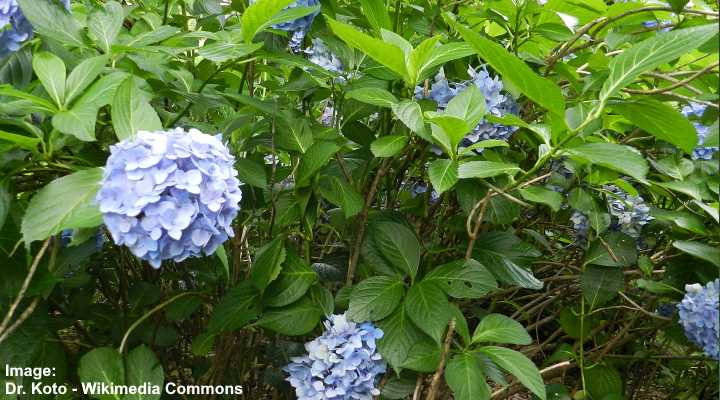
Hydrangea macrophylla ‘Nikko Blue’
Blushing Bride Hydrangea (Hydrangea macrophylla ‘Blushing Bride’): This low-maintenance, shade-loving perennial features large clusters of stunning white flowers with pink tips. Blooming in late summer, the attractive shrub grows 3 to 6 ft. (0.9 – 1.8 m) tall and wide.
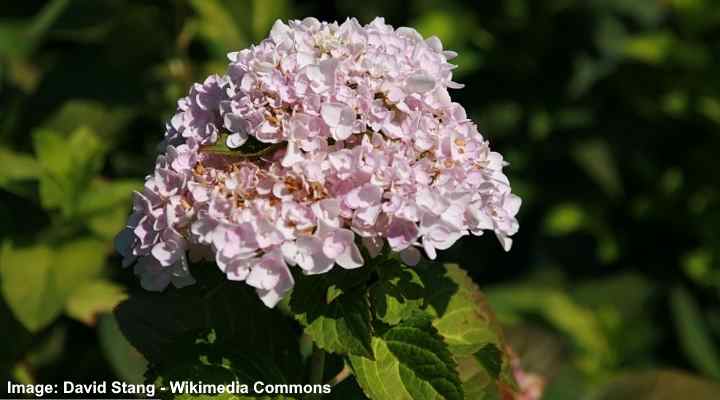
Hydrangea macrophylla ‘Blushing Bride’
Oakleaf Hydrangea (Hydrangea quercifolia): This white-flowering perennial shrub is ideal for gardens with low-light conditions. It features deep green, deeply lobed leaves, and creamy-white flowers in cone-like clusters. It grows 4 to 8 ft. (1.2 – 2.4 m) tall and up to 10 ft. (3 m) wide.
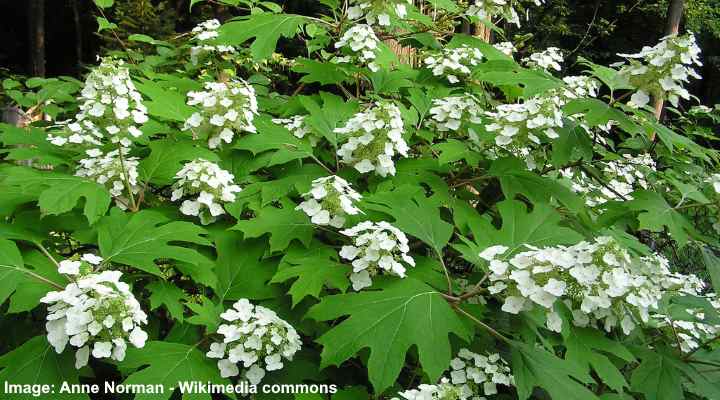
Oakleaf Hydrangea (Hydrangea quercifolia)
Hydrangeas are ideal for creating borders and hedges or as standalone focal points in shaded areas.
Further reading: Hydrangea: The Complete Care Guide.
- USDA Growing Zone: 5 to 9
- Blooming Time: Summer to fall
- Flower Colors: Blue, pink, purple, and white, depending on the variety and soil pH levels
- Light: Partial shade to full shade
- Soil: Rich, moist soils with excellent drainage
- Mature Size: 4 to 6 ft. (1.2 – 1.8 m) tall and wide
Lenten Roses (Helleborus)
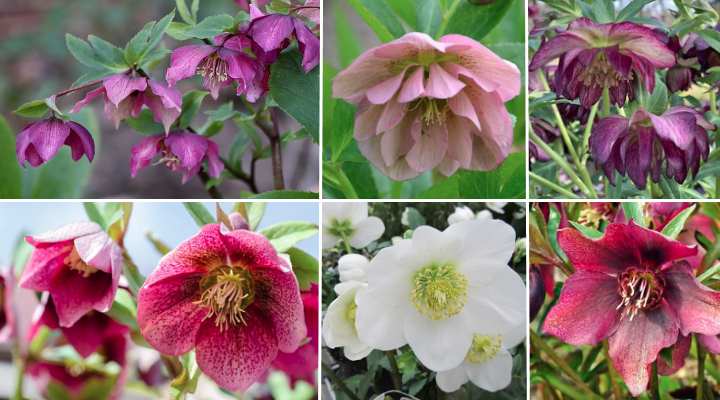
Lenten roses breathe vibrancy into shaded gardens due to their attractive saucer or cup-shaped flowers and large, leathery leaves. The perennial plants bloom in late winter and early spring with purple, pink, white, and green downward-facing flowers. Its foliage consists of palmate leaves divided into seven to nine segments.
Lenten roses have leathery, dark green foliage that remains attractive throughout the year. The cold-hardy evergreen perennials grow up to 2 ft. (0.6 m) and are ideal for compact gardens. Landscaping uses for the beautiful plants include shaded borders, ground cover for shade, and specimen plants.
Lenten roses also tolerate deer, rabbits, drought, and salt spray.
- USDA Growing Zone: 3 to 9
- Blooming Time: Late winter to early spring
- Flower Colors: White, pink, purple, green
- Light: Partial shade to deep shade
- Soil: Well-draining, slightly alkaline, organically rich soil
- Mature Size: 1 to 2 ft. (0.3 to 0.6 m) tall and wide
Solomon’s Seal (Polygonatum multiflorum)

Solomon’s seal is a graceful, shade-loving perennial with white bell-shaped flowers hanging from arching stems. The plant’s identifying features are its lanceolate, mid-green leaves that turn yellow in the fall, nodding flowers and blue-black berries. The attractive white-flowering, long-lived perennial spreads through rhizomes.
Solomon’s seal grows up to 3 ft. (0.9 m) tall and spreads slowly in shade gardens. Ideal growing conditions for the plant are moist, cool, sun-dappled, or shaded areas. It’s a good plant for planting under shrubs or trees or on the north side of buildings.
The low-maintenance perennial requires little care once established and is resistant to pests and diseases.
- USDA Growing Zone: 4 to 8
- Blooming Time: Late spring to early summer
- Flower Colors: White or creamy-white with pale green tips
- Light: Dappled shade, part shade, or full shade
- Soil: Moist, well-draining, humus-rich soil
- Mature Size: 2 to 3 ft. (0.6 to 0.9 m) tall and 1 ft. (0.3 m) wide
Spotted Dead Nettle (Lamium maculatum)
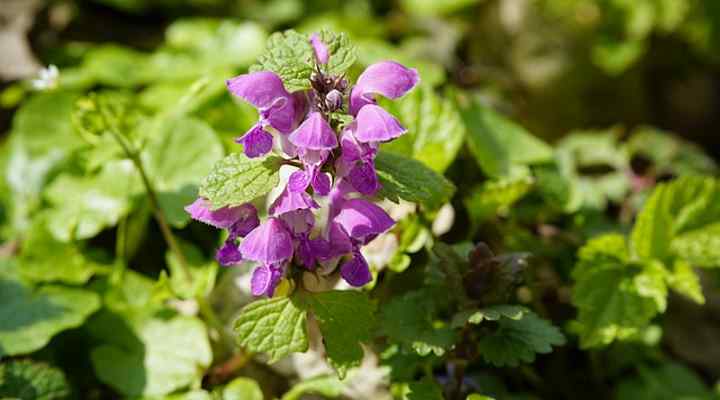
Spotted dead nettle is a versatile shade-loving perennial ground cover with heart-shaped leaves and small pink-purple flowers. The shade plant has heart-shaped, silvery-green leaves with green, serrated margins. Its tubular, magenta-purple flowers grow in attractive whorls at stem ends. It blooms from late spring through fall.
Spotted dead nettle is a low-growing plant up to 8” (20 cm) tall. It spreads quickly in heavy shade, forming a dense carpet-like mat that remains evergreen in mild winter regions. The drought-tolerant plant is ideal for ground cover, underplanting shrubs, edging, or filling empty spaces in perennial beds.
- USDA Growing Zone: 3 to 8
- Blooming Time: Spring and sporadically to fall
- Flower Colors: Pinkish-purple
- Light: Partial shade to complete shade
- Soil: Well-draining, moist, humus-rich soil
- Mature Size: 6” to 8” (15 – 20 cm) tall
Siberian Bugloss ‘Jack Frost’ (Brunnera macrophylla ‘Jack Frost’)
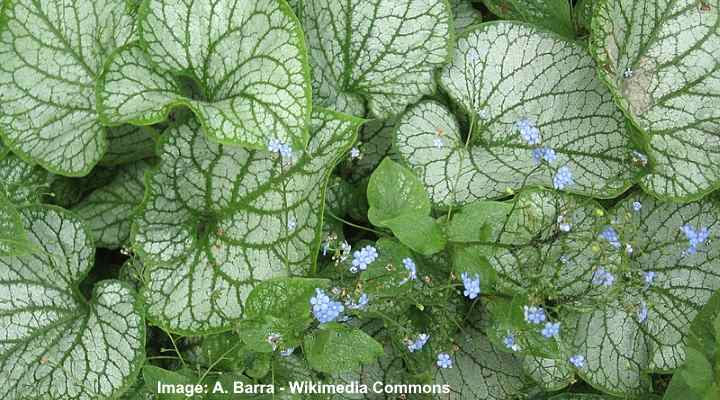
Siberian bugloss ‘Jack Frost’ is a beautiful, easy-care shade perennial with heart-shaped leaves and clusters of delicate sky-blue flowers. The plant’s foliage has green veins and silvery patches that grows in dense, lush clumps. Its five-petalled blue flowers grow in airy clusters, contrasting nicely with the attractive foliage.
‘Jack Frost’ Siberian bugloss grows up to 24” (60 cm) tall. Its tolerance for heavy shade and spreading nature make it ideal for ground cover in shade gardens. In addition, you can plant the shade-loving plant under shrubs, in perennial borders, and on banks to prevent soil erosion.
The versatile plant grows in cool climates and shady conditions, and deer and rabbits avoid its foliage.
- USDA Growing Zone: 3 to 8
- Blooming Time: Spring
- Flower Color: Light blue
- Light: Partial to full shade
- Soil: Organically rich, well-draining, moist soil
- Mature Size: 1 to 2 ft. (0.3 – 0.6 m) tall and wide
Ferns
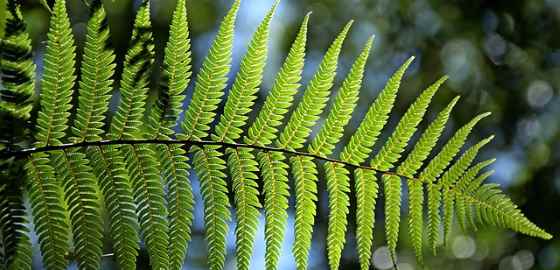
Ferns thrive in shade gardens, boasting lush, feathery fronds that add elegance and texture. Their adaptability to low-light conditions makes them ideal for creating evergreen or deciduous ground cover under canopies. A wide variety of ferns offer a diverse, low-maintenance landscaping solution for shaded areas.
Here are three popular easy-to-grow ferns for planting in shade gardens:
Northern Maidenhair Fern (Adiantum pedatum): This is one of the most popular ferns due to its low maintenance, handsome foliage, and tolerance for full shade. The deciduous fern has triangular pinnate fronds with pairs of leaflets on dark, wiry stems. This maidenhair fern variety grows 2.5 ft. (0.76 m) tall and 1.5 ft. (0.45 m) wide.
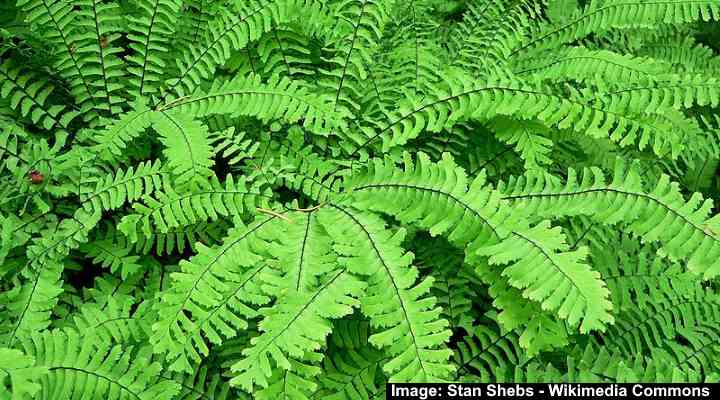
Northern Maidenhair Fern (Adiantum pedatum)
Painted Lady Fern (Athyrium niponicum var. pictum): This deciduous fern is ideal for adding a splash of color and texture to shade gardens. Its striking foliage features bright red arching stems with silver-gray fronds. It naturalizes easily in full shade and grows 1.5 ft. (0.45 m) tall and 2 ft. (0.6 m) wide.
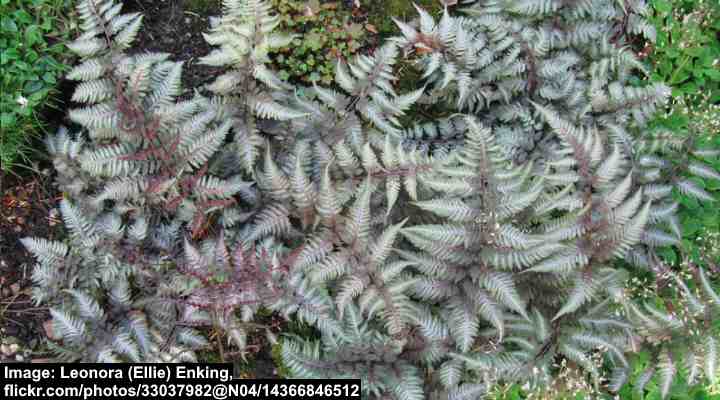
Painted Lady Fern (Athyrium niponicum var. pictum)
Japanese Painted Fern (Athyrium niponicum var. pictum ‘Burgundy Lace’): This shade-loving fern is ideal for adding greenery to shaded gardens. It features a rosette of arching fronds that emerge burgundy-purple and mature to silvery green. This elegant fern grows 1.5 ft. (0.45 m) tall and wide.
Leopard Plant (Ligularia przewalskii)

Leopard plants foster life in shaded gardens thanks to their dark green leaves and tall, yellow flower spikes. The striking, easy-care perennial has starry golden yellow flowers growing on erect stems up to 6 ft. (1.8 m) tall. It also has large, deep green palmate leaves with jagged lobes.
The leopard plant has a clumping habit and thrives in moist soil and partial to full shade. Its yellow blooms contrast with deep green foliage on tall stems, making a striking statement in low-light conditions. To add visual accents, you can plant it in moist soils near streams and ponds or at the back of the border.
- USDA Growing Zone: 4 to 8
- Blooming Time: Summer
- Flower Color: Golden yellow
- Light: Partial shade to full shade
- Soil: Moist, deep, fertile, well-draining soil that remains moist throughout the day
- Mature Size: 4 to 6 ft. (1.2 to 1.8 m) tall and 2 to 3 ft. (0.6 – 0.9 m) wide
Barrenwort (Epimedium)
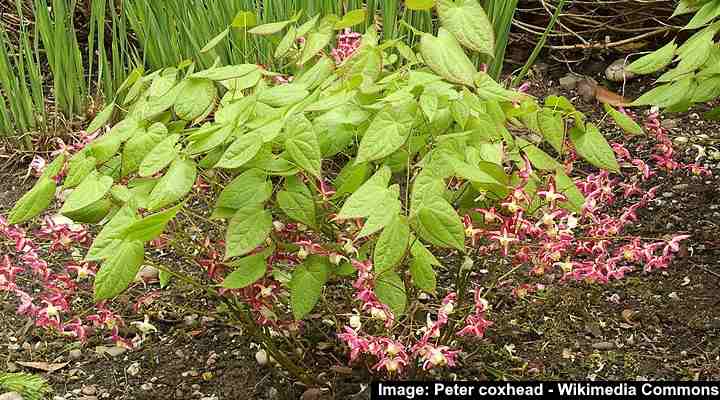
Epimedium × rubrum
Barrenwort is a no-fuss, shade-loving perennial perfect for planting in low-light areas of gardens. Its outstanding features are delicate, star-shaped, colorful flowers with thin, wiry petals growing in airy sprays. It also has heart-shaped leaves with prominent veining patterns. Also called bishop’s hat, the perennials don’t grow more than 2 feet (0.6 m) tall.
Barrenwort spreads slowly through rhizomes, making it suitable for flowering ground cover in heavy shade. The adaptable perennial thrives in various soil conditions and performs well in rock gardens, borders, garden edging, and containers. Barrenwort is also tolerant to drought, deer, rabbits, and rocky soil.
- USDA Growing Zone: 5 to 8
- Blooming Time: Spring to late fall
- Flower Colors: Pink, purple, yellow, white
- Light: Partial shade to deep shade
- Soil: Well-draining, acidic soils that have medium moisture and organic matter
- Mature Size: 1 to 2 ft. (0.3 – 0.6 m) tall and 2 to 3 ft. (0.6 – 0.9 m) wide
Hardy Orchids (Bletilla striata)

Hardy orchids are resilient perennials that are surprisingly easy to grow in partially shaded conditions. The stunning, delicate flowers have five spreading petals with a furrowed lower lip. Blooming in shades of pink and purple, the unique flowers sit atop long, slender stems surrounded by clumps of sword-shaped leaves.
Hardy orchids grow up to 2 ft. (0.6 m) tall. They spread through creeping rhizomes to naturalize low-light gardens in temperate climates. The easy-care perennial flowers perform well in perennial borders, beds, rock gardens, or containers.
Hardy orchids are perfect for adding a touch of exotic beauty to shaded garden areas, and they also make stunning cut flowers.
- USDA Growing Zone: 5 to 9
- Blooming Time: Throughout summer
- Flower Colors: Pink and purple
- Light: Partial shade
- Soil: Well-draining, organically rich soil types that remain consistently moist
- Mature Size: 1 to 2 ft. (0.3 – 0.6 m) tall and up to 1 ft. (0.3 m) wide
Bugleweed (Ajuga reptans)
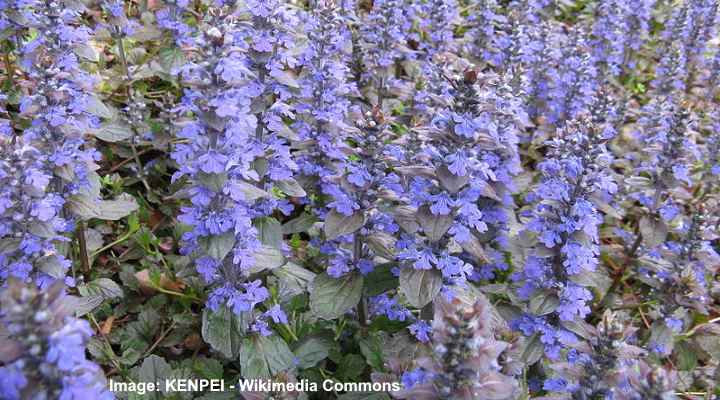
Bugleweed is an easy-to-grow, evergreen perennial that forms a carpet-like mat of vibrant foliage and purple or pink flowers. Blooming in spring and summer, bugleweed has tiny bluish-purple flowers growing in whorls on small stems. Evergreen leaves surround the flowering stems, making the low-growing perennial ideal for ground cover throughout the year.
Also called carpet bugle, the attractive wildflower doesn’t grow taller than 1 foot (0.3 m). The hassle-free spreading cold-hardy plant is ideal for erosion control, filling gaps in gardens, and underplanting shrubs where no sunlight gets through the canopy. Once established, bugleweed is drought-tolerant, deer-resistant, and attracts bees and butterflies.
- USDA Growing Zone: 3 to 10
- Blooming Time: Spring to early summer
- Flower Colors: Blue, purple, pink, and sometimes white
- Light: Full sun, partial shade, and complete shade
- Soil: Most soil types that are well-draining
- Mature Size: 4” to 8” (10 – 20 cm) tall and wide
Canada Wild Ginger (Asarum canadense)
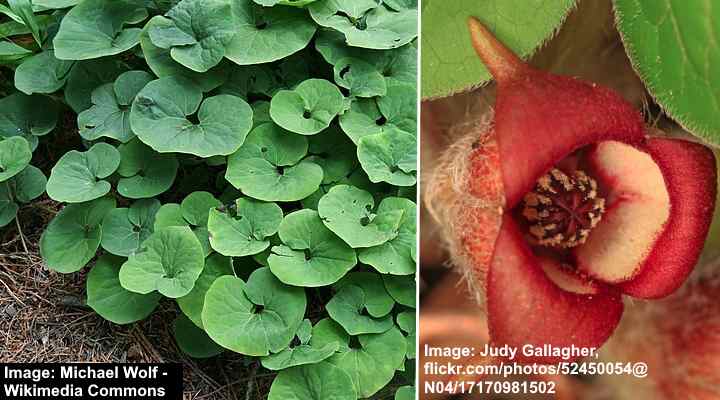
Canada wild ginger is an undemanding, hardy perennial plant that thrives in heavily shaded conditions. Features of this tough plant are its reddish-brown cup-shaped spring flowers, fuzzy heart-shaped leaves, and creeping habit. The ground-hugging plant’s leaves are large, measuring up to 6” (15 cm) wide.
Canada wild ginger is a shade lover that grows best in minimal light and moist environments. It doesn’t grow taller than a foot (0.3 m). You can plant it in shade gardens for edging, underplanting shrubs, or ground cover. The plant’s unusual flowers measure 1” (2.5 cm) and are hidden beneath its foliage.
- USDA Growing Zone: 4 to 6
- Blooming Time: Spring through fall
- Flower Color: Brownish-purple or reddish-brown
- Light: Shade to partial shade
- Soil: Moist, well-draining, neutral to acidic soil
- Mature Size: 6” to 12” (15 to 30 cm) tall and up to 24” (60 cm) wide
Blue Lilyturf (Liriope muscari)
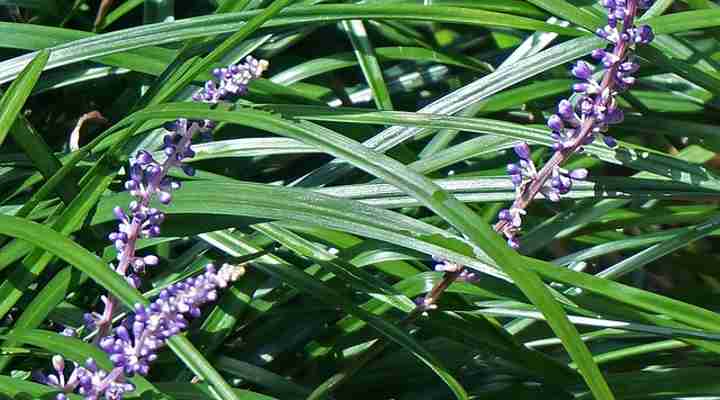
Blue lilyturf is a low-maintenance evergreen perennial plant ideal for a grass substitute in areas devoid of direct sunlight. Thriving in the shade, blue lilyturf has grass-like, strappy leaves growing in clumps. In late summer and fall, purple flowering spikes bloom, transforming shaded landscapes into a mat of vibrant colors before giving way to black berries.
Blue lilyturf, with its broad, arching leaves, grows no taller than 2 feet (0.6 m). The full-shade plant is perfect for planting under shrubs and trees, edging, and evergreen purple-flowering ground cover. It also works well in front of foundation plantings to add color and texture to a shaded side of a house.
- USDA Growing Zone: 5 to 10
- Blooming Time: Summer and fall
- Flower Colors: Blue or violet-purple
- Light: Full sun, partial shade, or deep shade
- Soil: Well-draining, moderately fertile soils
- Mature Size: 1 to 2 ft. (0.3 – 0.6 m) tall and wide
Silky Phacelia (Phacelia sericea)

Silky phacelia is an ideal low-maintenance flowering perennial for planting in partially shaded rocky soils. This long-lived plant is known for purple bottlebrush-like flowers growing on short stems. The purple-violet perennial flowers have a fuzzy appearance due to long stamens and yellow anthers. At the base, delicate, silky-textured, deeply-cut leaves give the plant a silvery look.
Silky phacelia grows up to 2 feet (0.6 m) tall in partial shade. The easy-care perennial performs well in drought-prone landscapes, growing in rock gardens, poor, rocky soils, or wildflower gardens. Its nectar-rich flowers also attract bees, butterflies, and other pollinators.
- USDA Growing Zone: 5 to 10
- Blooming Time: Throughout summer
- Flower Color: Purple-blue
- Light: Full sun to partial shade
- Soil: Well-draining soil
- Mature Size: 4” to 24” (10 – 24 cm) tall and 10” to 12” (25 – 30 cm) wide
Shade-Loving Clematis
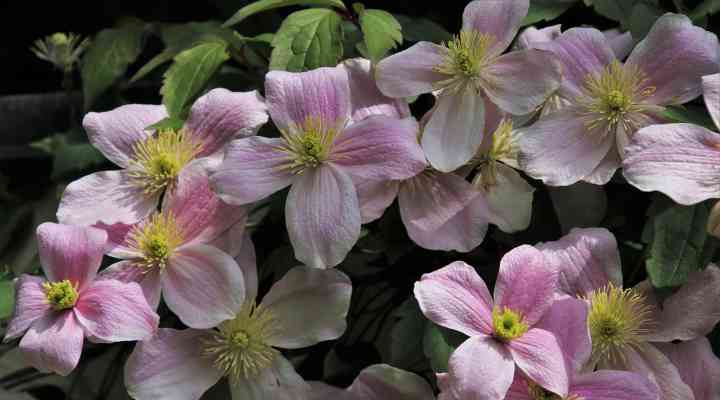
Clematis ‘Elizabeth’
Shade-loving clematis perennial vines are ideal for planting in shady garden areas with minimal sunlight. The climbing perennials are known for showy bell-shaped or starry flowers in various colors, including purple, pink, white, and blue. Shade-loving clematis leaves are typically dark green and glossy, providing an attractive backdrop for the flowers.
Many trailing and climbing clematis varieties grow in partial shade. Shade-loving clematis vines can grow 8 to 13 ft. (2.5 – 4 m) tall. They can climb fences, trellises, or arbors that are in areas of deep afternoon shade.
Further reading: Clematis: The Complete Care Guide.
- USDA Growing Zone: 4 to 9
- Blooming Time: Mid-summer through fall
- Flower Colors: Purple, pink, white, blue
- Light: Partial shade
- Soil: Well-draining, fertile soil
- Mature Size: Up to 13 feet (4 m) tall
Dwarf Crested Iris (Iris cristata)
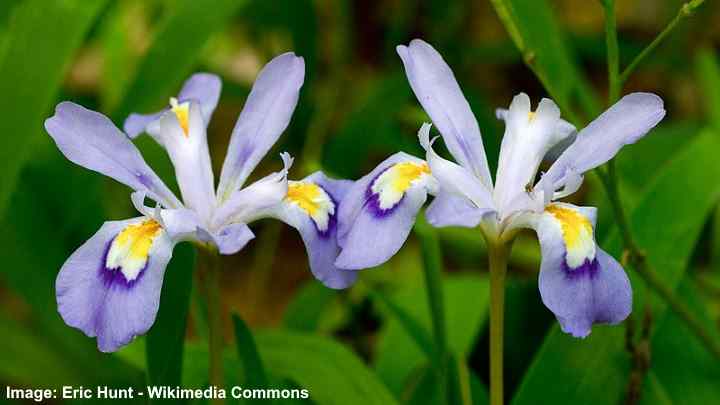
Dwarf crested iris is a charming shade perennial with delicate, blue-violet flowers. The features of this shade-loving plant are sword-shaped leaves and small light purple-blue flowers with crested petals. One petal is white with a conspicuous yellow patch. The low-growing perennial spreads easily in dappled sunlight or partially shaded gardens.
Dwarf crested iris plants don’t grow taller than a foot (0.3 m). Their spreading nature creates a carpet of light purple hues in garden areas with minimal direct sunlight. You can plant these flowers in perennial borders, beds, shaded rock gardens, and under large shrubs.
It’s good to remember that handling these iris plants can cause skin discomfort. They are also toxic to dogs and cats.
- USDA Growing Zone: 4 to 10
- Blooming Time: Mid to late spring
- Flower Color: Light purple or pale blue-violet
- Light: Partial shade
- Soil: Well-draining, moist, humus-rich soils and the flowers also perform well in dry shade
- Mature Size: 6” to 9” (15 – 22 cm) tall and 12” (30 cm) wide
Foam Flower (Tiarella cordifolia)
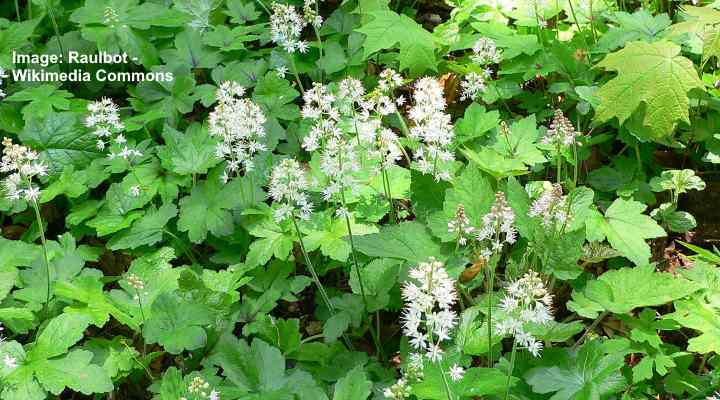
Foam flower is an herbaceous perennial that blooms in deep shade from spring through fall. Outstanding features of foam flowers are their conical clusters of small, fluffy white or pink flowers, slender stems, and glossy, heart-shaped, lobed leaves. The shade perennials don’t grow taller than one foot (0.3 m) tall.
Foam flowers typically thrive in garden areas with no direct sunlight. Spreading through rhizomes, the low-growing perennial naturalizes easily to form dense ground cover. The attractive flowers also perform well in shaded borders, underplanting shrubs, or other areas where plants struggle due to a lack of light.
- USDA Growing Zone: 3 to 8
- Blooming Time: Late spring to late fall
- Flower Colors: Creamy-white and pink
- Light: Partial shade to full shade
- Soil: Cool, humus-rich, moist, well-drained soil
- Mature Size: 10” to 12” (25 to 30 cm) tall and 12” to 24” (30 – 60 cm) wide
English Ivy (Hedera helix)

English ivy is an evergreen perennial known for vigorous growth despite growing in full shade. The fast-growing climbing vine features lobed or triangular dark green leaves, insignificant greenish-white flowers, and dark orange or black berries. The trailing evergreen vines also work well as ground cover in full shade.
English ivy requires no maintenance once established. The hardy perennial tolerates a wide range of difficult growing conditions—shade, drought, pests, diseases, and deer. This versatile evergreen plant is ideal for covering unsightly garden structures, walls, and fences. Its never-ending spread makes it an excellent choice for covering large areas of shaded ground.
- USDA Growing Zone: 5 to 11
- Light: Partial shade to full shade but also tolerates full sun
- Soil: Well-draining, fertile soil
- Mature Size: 20 to 30 ft. (6 – 9 m) tall and 15 ft. (4.5 m) wide
Bugbane (Actaea simplex)

Bugbane is a superb white-flowering perennial plant for adding height in deeply shaded garden areas. The striking shade plant has tall spikes of fragrant white bottlebrush flowers and finely divided leaves. The white flower clusters bloom in late summer through fall, attracting pollinators like bees, butterflies, and hummingbirds.
Bugbane grows up to 6 ft. (1.8 m) tall, creating a dramatic presence in low-light gardens. This easy-care, no-fuss perennial performs well in woodland gardens, borders, and naturalized areas. The attractive clumps of foliage and tall flowers also work well planted along a fence line in constant shadows.
The plant tolerates drought and is rabbit and deer-resistant, making it a great choice for gardens with wildlife problems. Its late-blooming time makes it ideal for adding color and texture to fall garden landscapes.
- USDA Growing Zone: 4 to 8
- Blooming Time: Late summer to early fall
- Flower Color: White
- Light: Partial to full shade
- Soil: Moisture-retentive soils that have plenty of organic matter
- Mature Size: 4 to 6 ft. (1.2 to 1.8 m) tall and 2 to 3 ft. (0.6 to 0.9 m) wide
Low Maintenance Perennials for a Shade Garden – Frequently Asked Questions (FAQs)
What’s the Difference Between “Full Shade” and “Partial Shade”?
“Full shade” refers to areas with no direct sunlight, but they may still receive some ambient or diffused light during the day. It doesn’t mean total darkness. On the other hand, “partial shade” describes areas that receive some direct sunlight, typically for a few hours in the early morning or late afternoon. This creates a transitional zone where plants can tolerate a mix of sun and shade. Understanding these terms is important for selecting plants that match the specific light conditions in a given area.
Are “Low Shade Indoor Plants” Similar to “Outdoor Shade Plants”?
“Low shade indoor plants” and “outdoor shade plants” may have some similarities, but they can differ due to their respective environments. Indoor plants are adapted to controlled settings and often originate from tropical regions, thriving in lower light conditions. Outdoor shade plants, however, are naturally suited for garden or landscape settings, exposed to various outdoor elements.
While certain plants may be suitable for both environments, it’s essential to consider specific care needs. Indoor plants might require adjusted care, such as modified watering and occasional exposure to filtered sunlight. Always check the individual care requirements for each plant to ensure they thrive in either indoor or outdoor shaded conditions.
How Often Should I Water My Shade-Loving Plants?
The watering frequency for shade-loving plants depends on factors like the plant type, soil moisture, and seasonal variations. Generally, the soil should be consistently moist but not waterlogged.
Different shade-loving plants have varying water requirements, so it’s essential to check the specific needs of each plant. Adjust watering based on seasonal changes, providing more water during hot and dry periods.
Applying mulch helps retain soil moisture and regulates temperature. For container plants, be aware that they may need more frequent watering. Observing visual cues, such as wilting or yellowing leaves, can guide your watering schedule.
Watering in the early morning is beneficial, allowing plants to absorb moisture before the heat of the day. Overall, regular monitoring and adapting to the specific conditions of your shade garden contribute to plant health.
Can I Mix “Low Sun Perennials” with “Full Shade Perennials”?
Yes, you can mix “low sun perennials” with “full shade perennials.” However, it’s crucial to consider the sunlight requirements of each plant. Group them based on their tolerance for sunlight, ensuring that those with similar needs are planted together. Additionally, take into account soil moisture, height, and growth habits when arranging the plants. Be aware of seasonal changes and variations in light throughout the year, adjusting the placement of the plants accordingly.
Why Opt for a Shade Garden?
Opting for a shade garden provides cooler temperatures in the hot summer months, making it a comfortable retreat. These areas retain moisture better, reducing the need for frequent watering. Shade gardens offer a unique variety of plants that thrive in low light conditions, often overlooked in traditional sun gardens. The play of light and shadows creates a serene atmosphere, enhancing the garden’s aesthetic appeal. While there are challenges, such as limited plant choices and potential for pests, thoughtful planning can address these issues, resulting in a thriving and visually appealing shade garden.
What Are the Challenges of a Shade Garden?
The challenges of a shade garden involve limited plant choices and potential soil quality issues (compaction or nutrient-poor soil). The environment which is cooler and moister, may attract pests and diseases, while competition with tree roots for nutrients poses another obstacle. Lower light levels impact plant growth, leading to an extended establishment time. Seasonal changes in light levels and potential visual monotony due to green foliage prevalence are additional considerations. Addressing these challenges requires careful plant selection, soil enrichment, pest management, and strategic garden design.
Related articles:
